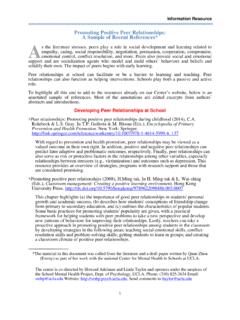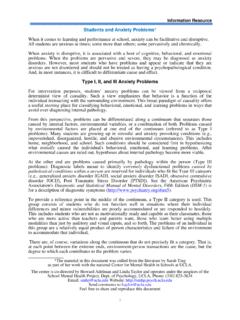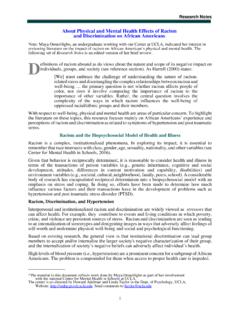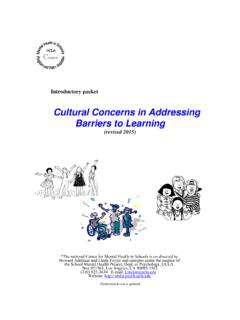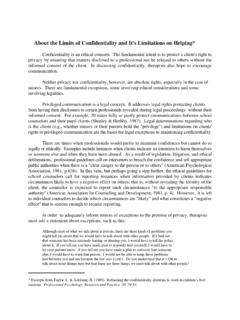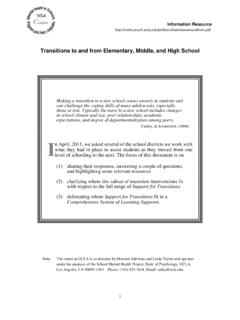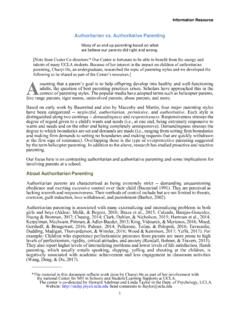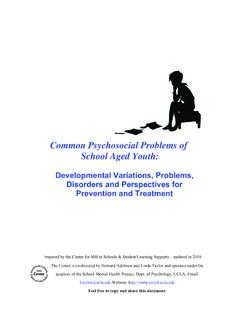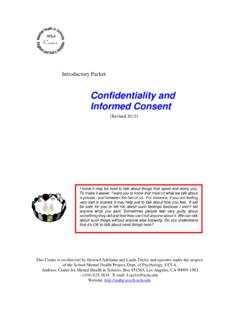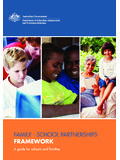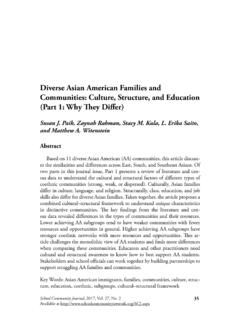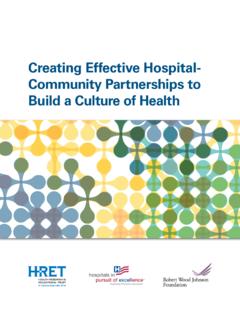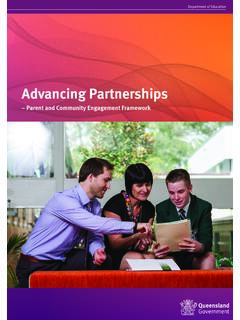Transcription of School-Community Partnerships: A Guide
1 School-Community Partnerships: A Guide This Center is co-directed by Howard Adelman and Linda Taylor and operates under the auspices of the School Mental Health Project, Dept. of Psychology, UCLA. Center for Mental Health in Schools, Box 951563, Los Angeles, CA 90095-1563. (310) 825-3634 Fax: (310) 206-5895; E-mail: Website: Permission to reproduce this document is granted. Please cite source as the Center for Mental Health in Schools at UCLA. School-Community Partnerships: A Guide Table of Contents Executive Summary i Preface 1. Introduction 2. I. Why School-Community Partnerships? 5. Definitions 9. Dimensions and Characteristics 12. Principles 14. State of the Art 16. Recommendations to Enhance School-Community Partnerships 32. II. Building and Maintaining Effective Collaboratives 37. Building from Localities Outward 43. Mechanisms 46. A Multi-Locality Collaborative 50.
2 Barriers to Collaboration 54. III. Getting from Here to There 58. What Are Some of the First Steps? 61. Mechanisms for Systemic Change 62. A Bit More about the Functions of a Change Agent and Change Team 63. A Note of Caution 66. Concluding Comments 68. References Appendices A: A Comprehensive, Multifaceted Continuum of Intervention: Understanding the Big Picture B: Reported Examples of Successful School-Community Initiatives C: Melaville and Blank's Sample of School-Community Partnerships D: A Beginning Look at Major School-Community Partnerships in LA County Resource Aids I. Tools for Mapping Resources II. Examples of Funding Sources III. Working with Others to Enhance Programs and Services IV. Tools for Gap Analysis and Action Planning V. Using Data for Planning, Implementation, and Evaluation VI. Legal Issues VII. Agencies and Online Resources Relevant to School-Community Tables and Figures Table 1.
3 Some key dimensions relevant to family-community-school collaborative arrangements 12. Table 2. Four overlapping areas of School-Community collaboration: A Local Example 28. Table 3. A range of community resources that could be part of a collaboration 31. Table 4. An overview of steps in moving School-Community partnerships from 44. projects to wide-spread practice Figure 1a. Framework outlining areas for School-Community collaboration. 13. Figure 1b. Nature and scope of collaboration. 13. Exhibit 1 About collaborative infrastructure 42. Exhibit 2 Examples of task activity for a change agent 64. Exhibit 3 Planning and facilitating effective meetings 66. School-Community Partnerships: A Guide Executive Summary Recent years have seen an escalating expansion in School-Community linkages. Initiatives are sprouting in a rather dramatic and ad hoc manner.
4 These efforts could improve schools, strengthen neighborhoods, and lead to a marked reduction in young people's problems. Or, such "collaborations" can end up being another reform effort that promised a lot, did little good, and even did some harm. It is time to document and analyze what has developed and move forward with a renewed sense of purpose and direction. This guidebook briefly underscores the why of school-family-community collaborations highlights their key facets sketches out the state of the art across the country offers some recommendations for local school and community policy makers discusses steps for building and maintaining School-Community partnerships includes some tools for developing such partnerships. Why School- Increasingly, it is evident that schools, families , and Community communities should work closely with each other to meet their mutual goals.
5 Schools are located in communities , but often Partnerships? are islands with no bridges to the mainland. families live in neighborhoods, often with little connection to each other or to the schools their youngsters attend. Neighborhood entities such as agencies, youth groups, and businesses have major stakes in the community. All these entities affect each other, for good or bad. Because of this and because they share goals related to education and socialization of the young, schools, homes, and communities must collaborate with each other if they are to minimize problems and maximize results. Interest in working together is bolstered by concern about widespread fragmentation of school and community Policy makers must interventions and problems of access. The hope is that by integrating available resources, a significant impact can be realize that, as important made on at risk factors.
6 In particular, appropriate and as it is to reform and effective collaboration and teaming are seen as key facets of restructure health and addressing barriers to development, learning, and family self- human services, such sufficiency. services remain only one facet of a comprehensive, While informal school-family-community linkages are cohesive approach for relatively simple to acquire, establishing major long-term strengthening families connections is complicated. They require vision, cohesive and neighborhoods. policy, and basic systemic reform. The difficulties are readily seen in attempts to evolve a comprehensive, multifaceted, and integrated continuum of School-Community interventions. Such a comprehensive continuum involves more than con- necting with the community to enhance resources to support i instruction, provide mentoring, and improve facilities.
7 It involves more than school-linked, integrated services and activities. It requires weaving school and community resources together in ways that can only be achieved through connections that are formalized and institutionalized, with major responsibilities shared. School-Community partnerships often are referred to as What are School- collaborations. Optimally, such partnerships formally blend together resources of at least one school and sometimes a Community group of schools or an entire school district with resources in Partnerships? a given neighborhood or the larger community. The intent is to sustain such partnerships over time. The range of entities in a community are not limited to agencies and organization;. they encompass people, businesses, community based organi- zations, postsecondary institutions, religious and civic groups, programs at parks and libraries, and any other facilities that can be used for recreation, learning, enrichment, and support.
8 School-Community partnerships can weave together a critical mass of resources and strategies to enhance caring com- munities that support all youth and their families and enable success at school and beyond. Strong School-Community connections are critical in impoverished communities where schools often are the largest piece of public real estate and also may be the single largest employer. Comprehensive partnerships represent a promising direction for generating essential interventions to address barriers to learning, enhance healthy development, and strengthen families and neighbor- hoods. Building such partnerships requires an enlightened vision, creative leadership, and new and multifaceted roles for professionals who work in schools and communities , as well as for all who are willing to assume leadership. In thinking about School-Community partnerships, it is essential not to overemphasize the topics of coordinating community services and co-locating services on school sites.
9 Such thinking downplays the need to also restructure the various education support programs and services that schools own and operate. And, it has led some policy makers to the mistaken impression that community resources can effectively meet the needs of schools in addressing barriers to learning. In turn, this has led some legislators to view the linking of community services to schools as a way to free-up the dollars underwriting school-owned services. The reality is that even when one adds together community and school assets, the total set of services in impoverished locales is woefully inadequate. In situation after situation, it has become evident that as soon as the first few sites demonstrating school- community collaboration are in place, community agencies find they have stretched their resources to the limit. ii A Growing Movement Projects across the country demonstrate how schools and communities connect to improve results for youngsters, families , and neighborhoods.
10 Various levels and forms of School-Community collaboration are being tested, including state-wide initiatives in California, Florida, Kentucky, Missouri, New Jersey, Ohio, and Oregon, among others. The aims are to improve coordination and eventually integrate many programs and enhance linkages with school sites. To these ends, projects incorporate as many health, mental health, and social services as feasible into "centers" (including school-based health centers, family and parent centers) established at or near a school. They adopt terms such as school-linked and coordinated services, wrap-around, one-stop shopping, full service schools, systems of care, and community schools. There are projects to (a) improve access to health and social services, (b) expand after school academic, recreation, and enrichment, (c) build systems of care, (d) reduce delinquency, (e) enhance transitions to work/career/post-secondary education, and (f) enhance life in school and community.
